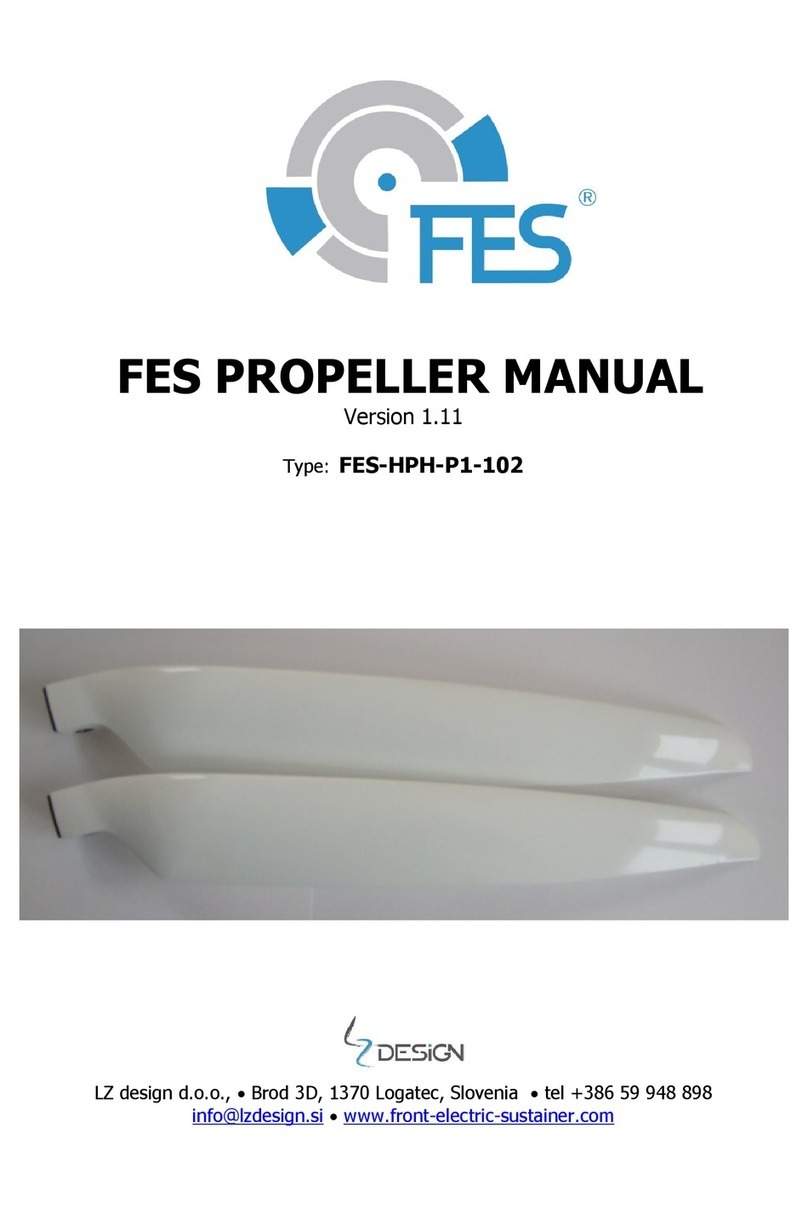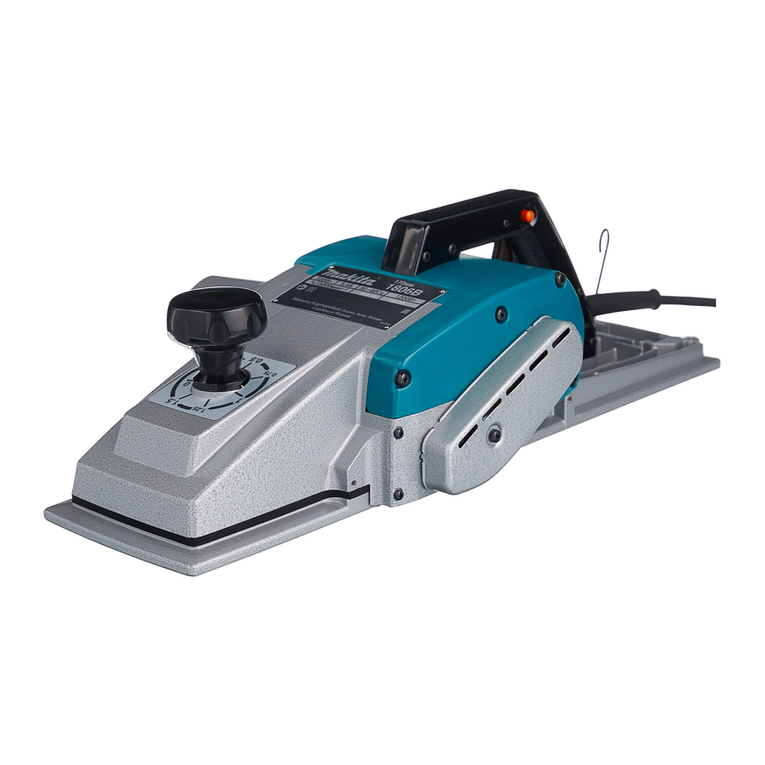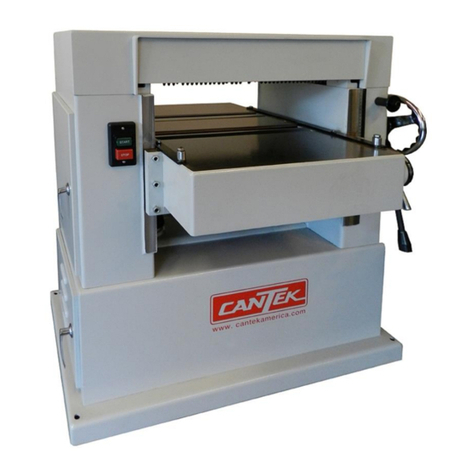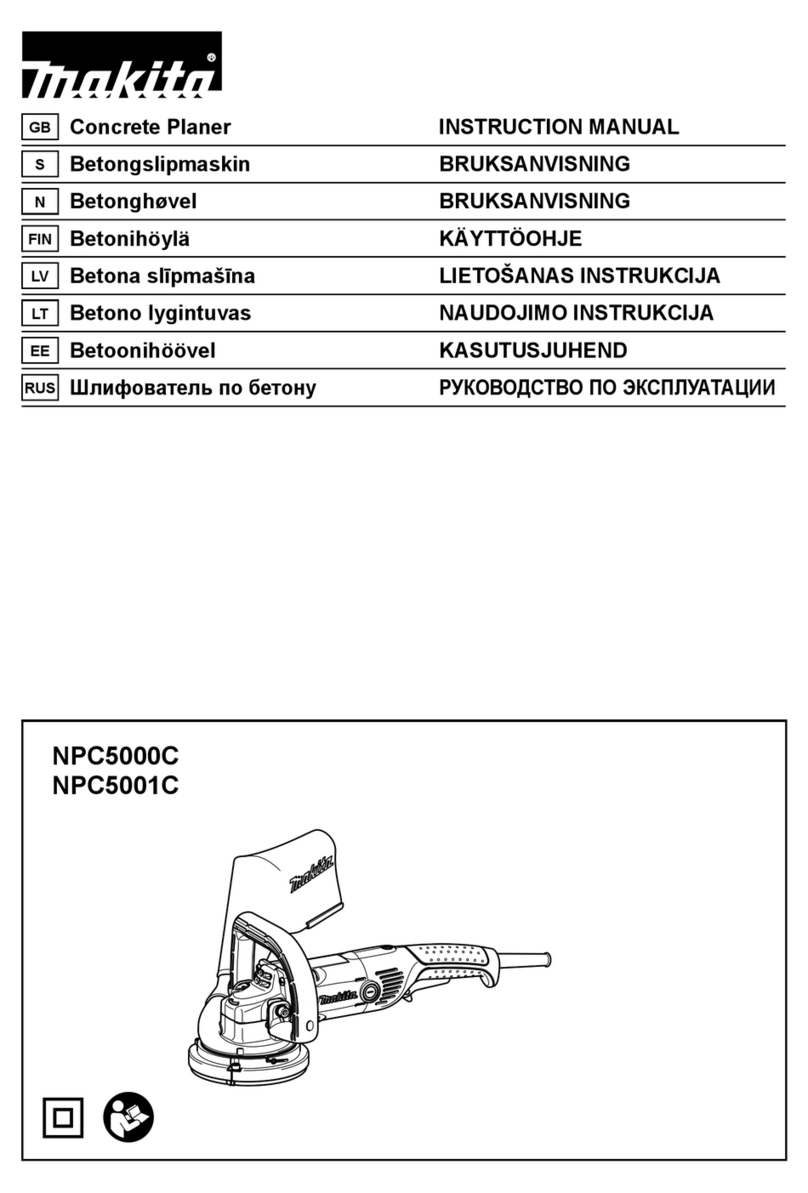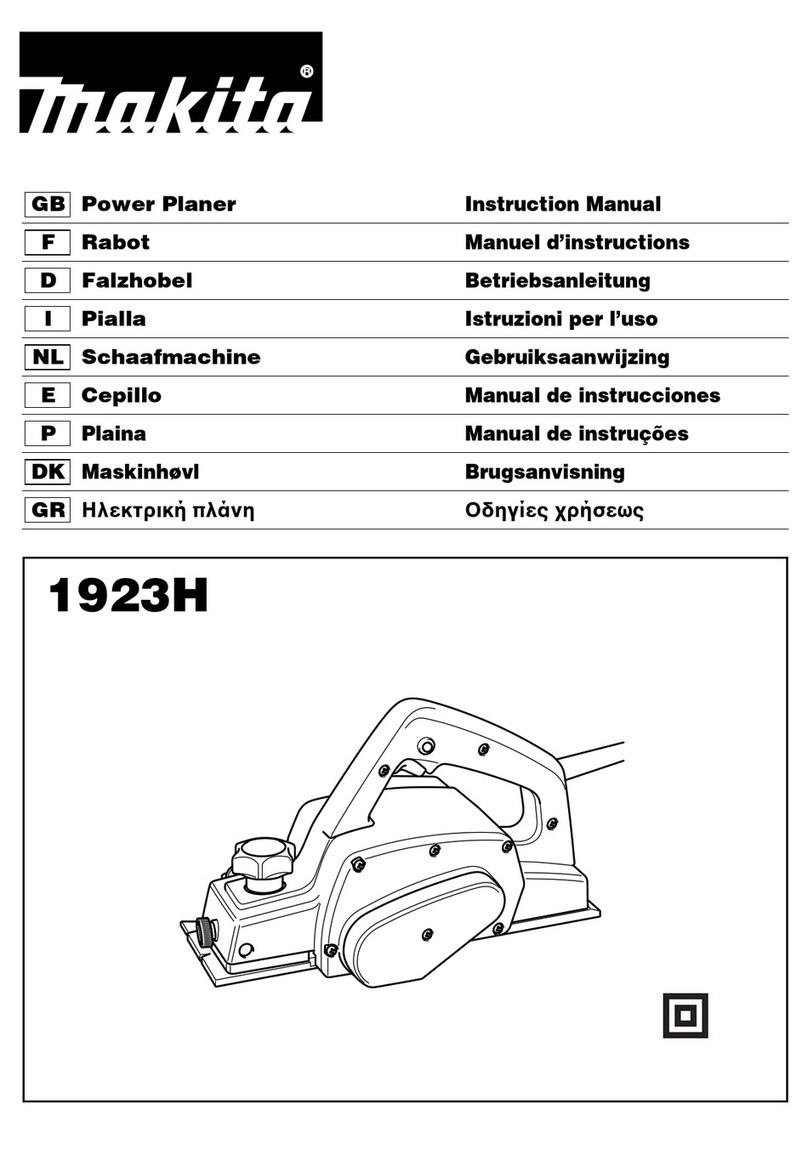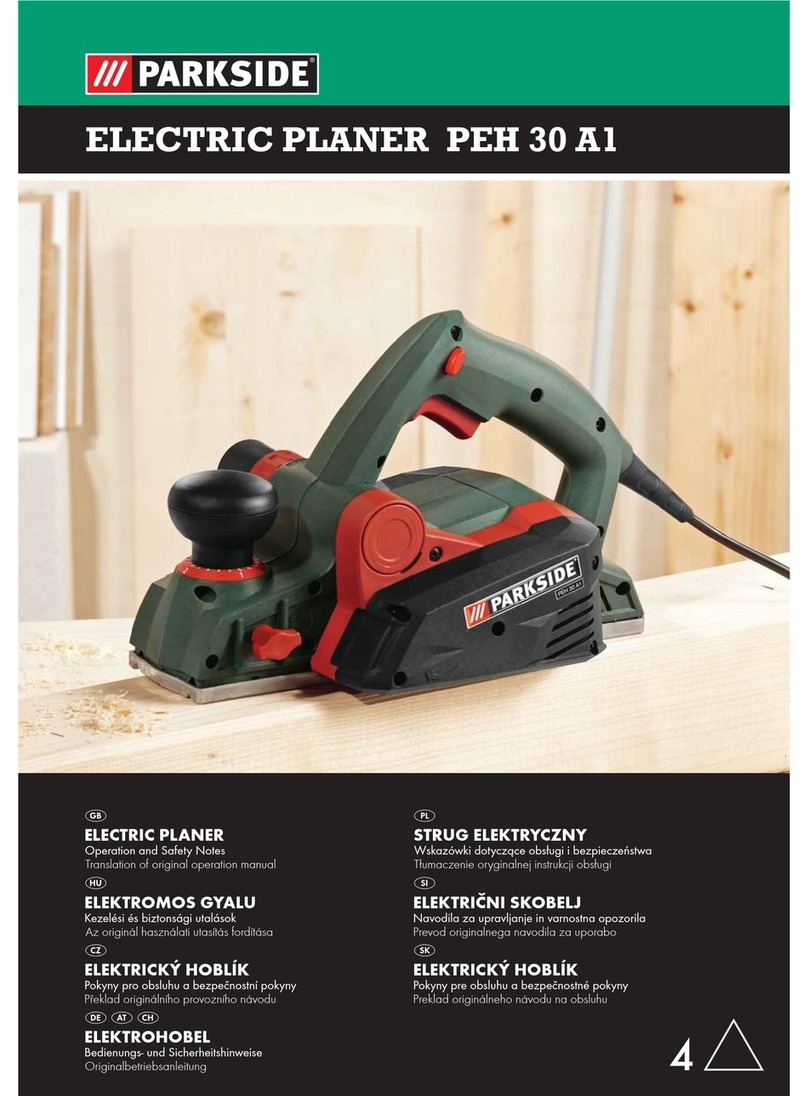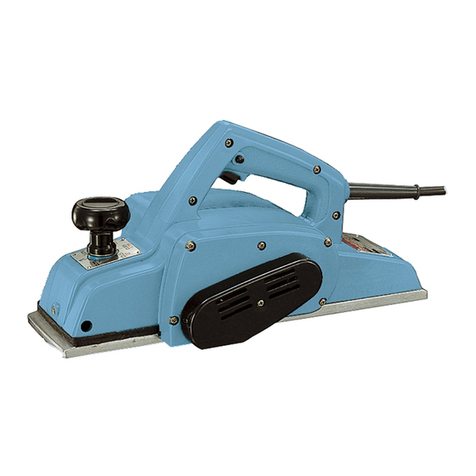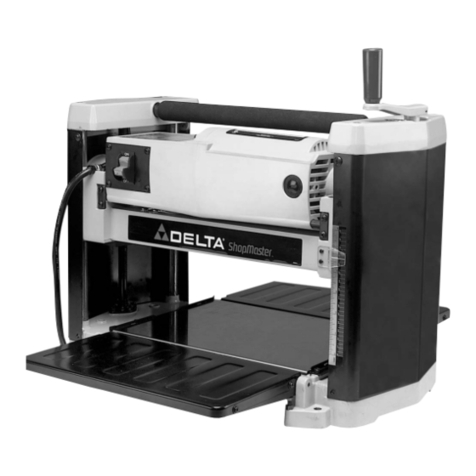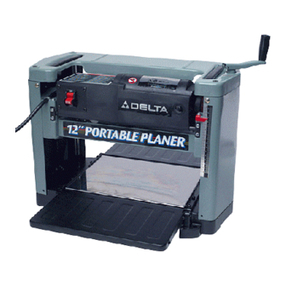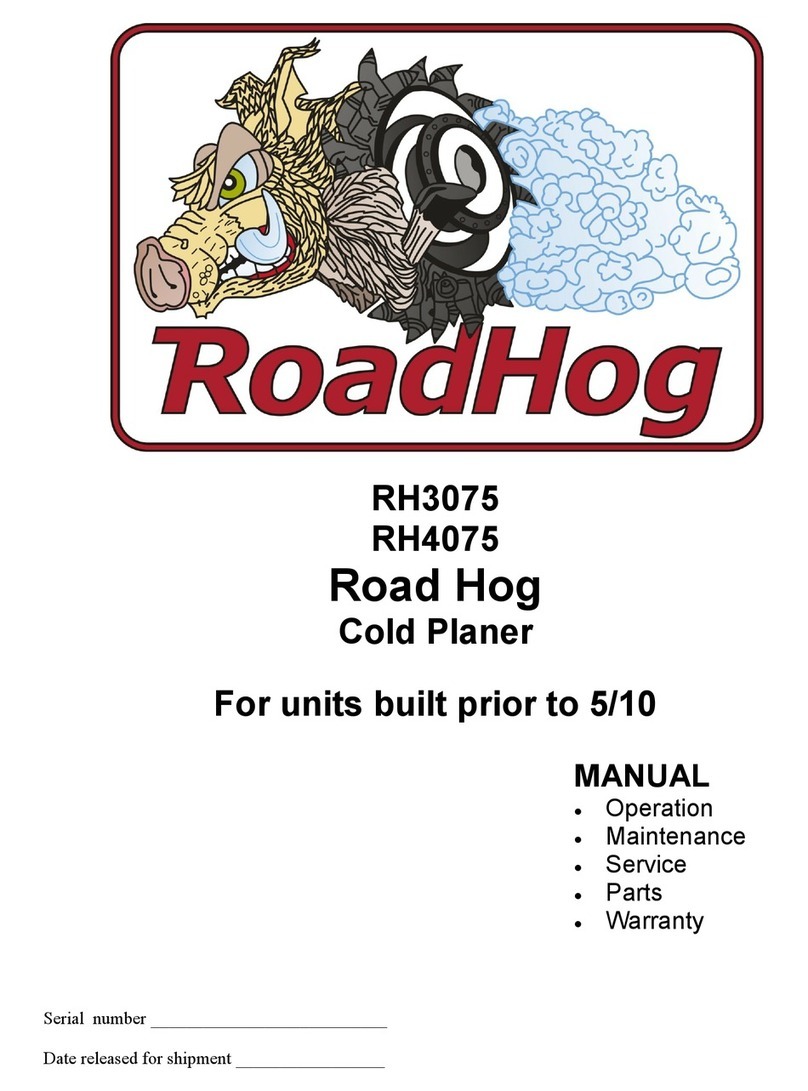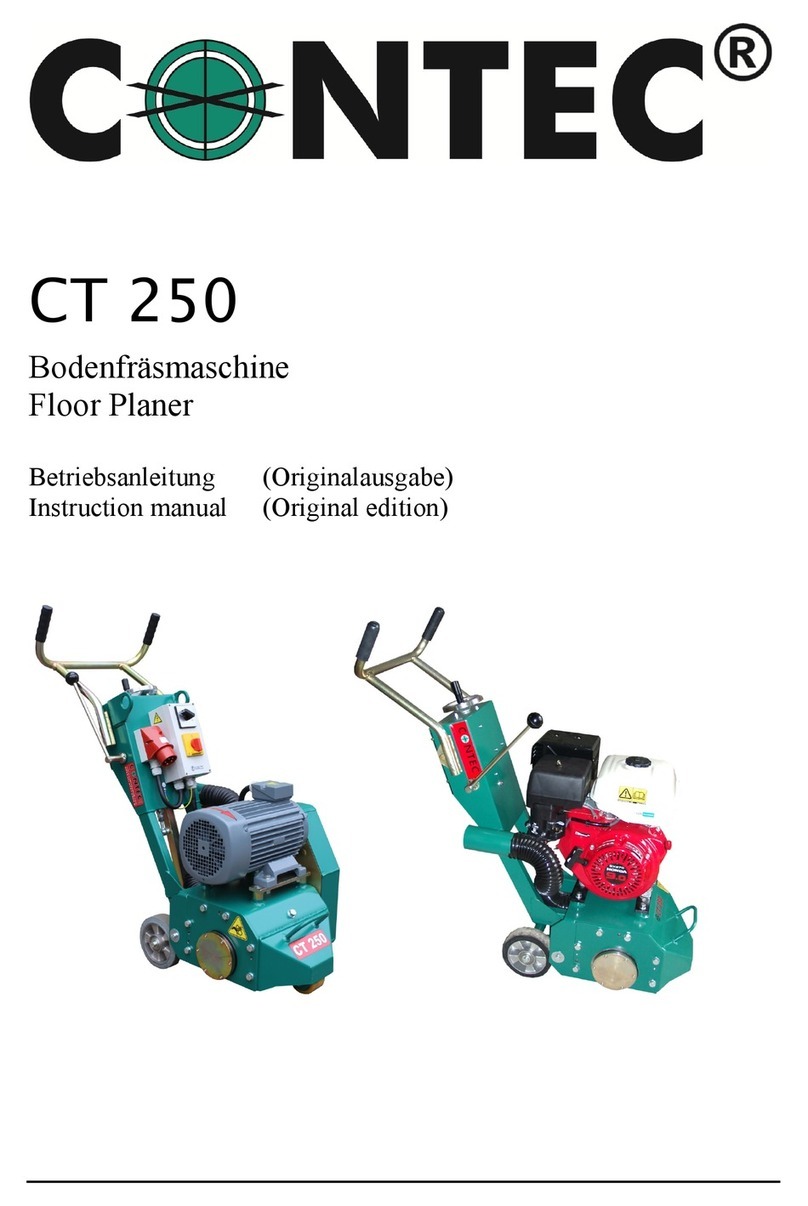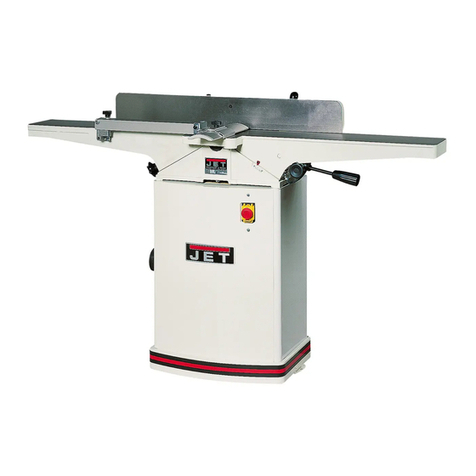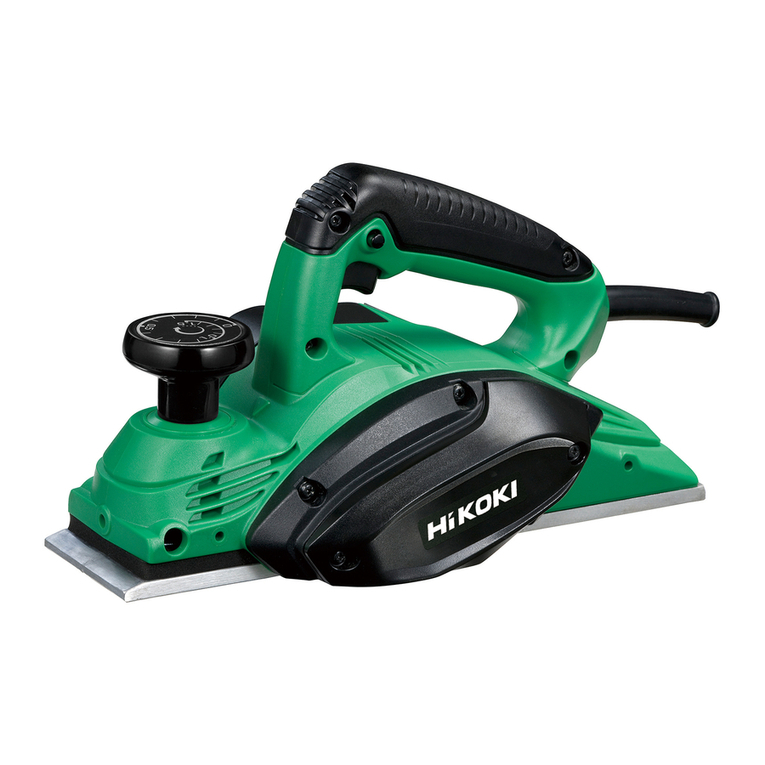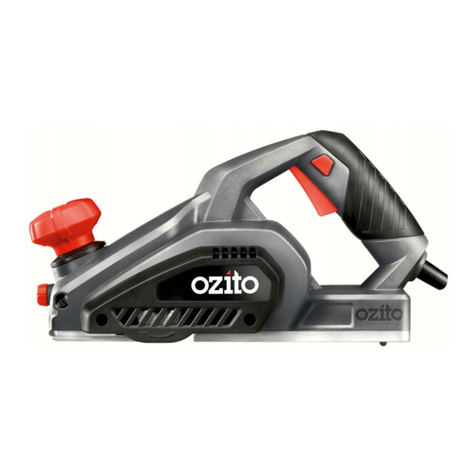Clarke CEP450 Instruction Manual

OPERATION & MAINTENANCE
INSTRUCTIONS
LS0419 - ISS 1
ORIGINAL INSTRUCTIONS
60MM ELECTRIC PLANER
MODEL NO: CEP450
PART NO: 6462022

2
Parts & Service: 020 8988 7400 / E-mail: Parts@clarkeinternational.com or Service@clarkeinternational.com
INTRODUCTION
Thank you for selecting this Clarke Electric Planer.
The electric planer is intended for removing surface material with a rotating
blade that is parallel to the base plate.
GUARANTEE
The product is guaranteed against faulty manufacture for a period of 12
months from the date of purchase. Your receipt is required as proof of
purchase.
This guarantee is invalid if the product is found to have been abused,
tampered with, or not used for the purpose for which it was intended.
Faulty goods must be returned to their place of purchase, do not return it to us
without prior permission.
This guarantee does not effect your statutory rights.
ENVIRONMENTAL RECYCLING POLICY
Through purchase of this product, the customer is taking on the
obligation to deal with the WEEE in accordance with the WEEE
regulations in relation to the treatment, recycling & recovery and
environmentally sound disposal of the WEEE.
In effect, this means that this product must not be disposed of with general
household waste. It must be disposed of according to the laws governing
Waste Electrical and Electronic Equipment (WEEE) at a recognised disposal
facility.

3
Parts & Service: 020 8988 7400 / E-mail: Parts@clarkeinternational.com or Service@clarkeinternational.com
GENERAL POWER TOOL SAFETY WARNINGS
Save all warnings and instructions for future reference.
The term “power tool” in the warnings refers to your mains-operated electric
planer.
WORK AREA SAFETY
1. Keep work area clean and well lit. Cluttered or dark areas invite accidents.
2. Do not operate power tools in explosive atmospheres, such as in the
presence of flammable liquids, gases or dust. Power tools create sparks
which can ignite the dust or fumes.
3. Keep children and bystanders away while operating a power tool.
Distractions can cause you to lose control.
ELECTRICAL SAFETY
1. Power tool plugs must match the outlet. Do not modify the plug in any way.
Do not use any adapter plugs with earthed (grounded) power tools.
Unmodified plugs and matching outlets will reduce risk of electric shock.
2. Avoid body contact with earthed or grounded surfaces, such as pipes,
radiators, ranges and refrigerators. There is an increased risk of electric
shock if your body is earthed or grounded.
3. Do not expose power tools to rain or wet conditions. Water entering a
power tool will increase the risk of electric shock.
4. Do not abuse the cord. Do not use the cord for carrying, pulling or
unplugging the power tool. Keep cord away from heat, oil, sharp edges or
moving parts. Damaged or entangled cords increase the risk of electric
shock.
5. When operating a power tool outdoors, use an extension cord suitable for
outdoor use. Use of a cord suitable for outdoor use reduces the risk of
electric shock.
6. If operating a power tool in a damp location is unavoidable, use a residual
current device (RCD) protected supply. Use of an RCD reduces the risk of
electric shock.
WARNING: READ ALL SAFETY WARNINGS AND ALL INSTRUCTIONS.
FAILURE TO FOLLOW THE WARNINGS AND INSTRUCTIONS CAN RESULT IN
ELECTRIC SHOCK, FIRE AND/OR INJURY.

4
Parts & Service: 020 8988 7400 / E-mail: Parts@clarkeinternational.com or Service@clarkeinternational.com
PERSONAL SAFETY
1. Stay alert, watch what you are doing and use common sense when
operating a power tool. Do not use a power tool while you are tired or
under the influence of drugs, alcohol or medication. A moment of
inattention while operating power tools can result in personal injury.
2. Use personal protective equipment. Always wear eye and ear protection.
Protective equipment such as dust mask, non-skid safety shoes, hard hat,
or hearing protection used for appropriate conditions will reduce personal
injuries.
3. Prevent unintentional starting. Ensure the switch is in the off position before
connecting to power source, picking up or carrying the tool. Carrying
power tools with your finger on the switch or energising power tools that
have the switch on invites accidents.
4. Remove any adjusting key or wrench before turning the power tool on. A
wrench or a key left attached to a rotating part of the power tool can
result in personal injury.
5. Do not overreach. Keep proper footing and balance at all times. This
enables better control of the power tool in unexpected situations.
6. Dress correctly. Do not wear loose clothing or jewelry. Keep your hair and
clothing away from moving parts. Loose clothes, jewelry or long hair can
be caught in moving parts.
7. If devices are provided for the connection of dust extraction and collection
facilities, ensure these are connected and correctly used. Use of dust
collection can reduce dust-related hazards.
POWER TOOL USE AND CARE
1. Do not force the power tool. Use the correct power tool for your
application. The correct power tool will do the job better and safer at the
rate for which it was designed.
2. Do not use the power tool if the switch does not turn it on and off. Any
power tool that cannot be controlled with the switch is dangerous and
must be repaired.
3. Disconnect the plug from the power source before making any
adjustments, changing accessories, or storing power tools. Such preventive
safety measures reduce the risk of starting the power tool accidentally.
4. Store idle power tools out of the reach of children and do not let persons
unfamiliar with the power tool or these instructions to operate the power
tool. Power tools are dangerous in the hands of untrained users.
5. Maintain power tools. Check for misalignment or binding of moving parts,
breakage of parts and any other condition that can affect the power tool's

5
Parts & Service: 020 8988 7400 / E-mail: Parts@clarkeinternational.com or Service@clarkeinternational.com
operation. If damaged, have the power tool repaired before use. Many
accidents are caused by poorly maintained power tools.
6. Keep cutting tools sharp and clean. Sharp cutting edges are less likely to
bind and are easier to control.
7. Use the power tool, accessories and tool bits etc. in accordance with these
instructions, taking into account the working conditions and the work to be
performed. Use of the power tool for operations different from those
intended could result in a hazardous situation.
SERVICE
1. Have your power tool serviced by a qualified repair person using only
identical replacement parts. This will ensure that the safety of the power
tool is maintained.
PLANER SAFETY WARNINGS
1. Wait for the blade to stop before setting the planer down. An exposed
rotating blade can strike the worktop, leading to possible loss of control
and injury.
2. Hold the planer by insulated gripping surfaces, because the blade may
contact its own cable. Cutting a “live” wire may make exposed metal parts
of the planer “live” and could give the operator an electric shock.
3. Use clamps or another practical way to secure and support the workpiece
to a stable platform. Holding the workpiece by your hand or against the
body leaves it unstable and can lead to loss of control.
4. Always start the planer before the blade is in contact with the workpiece
and let the blade reach full speed. The tool can vibrate or chatter if blade
speed is too slow at beginning of the cut and possibly kickback.
5. Check the workpiece for nails or screws. If there are nails/screws, either
remove or set them well below intended finished surface. Kickback,
damage to the blades and personal injury can result If the planer blades
strike objects like nails.
6. Unplug the planer before changing accessories. Before plugging the
planer in, check that the trigger lock is “OFF”. Accidental start-ups can
occur if the planer is plugged in while changing an accessory.
7. After changing blades, rotate the blade drum to make sure the blades are
not hitting any part of the housing and that the blade locking screws are
tight. Spinning blades could strike the tool housing and damage the tool as
well as causing possible injury.
8. Always hold the planer firmly with both hands for maximum control.

6
Parts & Service: 020 8988 7400 / E-mail: Parts@clarkeinternational.com or Service@clarkeinternational.com
9. Do not pull the plane backward over the workpiece. Loss of control can
occur.
10. Do not put your fingers or any objects into the shavings exhaust port or
clean out shavings while the tool is running. Contact with blade will cause
injury.
11. Remove the plug from the power source if it becomes necessary to remove
woodchips. The blades are hidden from view and you may be cut if the
blade is touched.
12. Do not use dull or damaged blades. Sharp blades must be handled with
care. Damaged blades can snap during use. Dull blades require more
force to push the tool, possibly causing the blade to break.
SAFETY SYMBOLS
Read instruction manual before use
Wear safety glasses
Wear ear defenders

7
Parts & Service: 020 8988 7400 / E-mail: Parts@clarkeinternational.com or Service@clarkeinternational.com
ELECTRICAL CONNECTIONS
This tool is provided with a standard 13 amp, 230 volt (50Hz), BS 1363 plug, for
connection to a standard, domestic electrical supply. If the plug need
changing, make sure that a plug of identical specification is used.
If the colours of the wires in the power cable do not correspond with the
markings on the terminals of your plug, proceed as follows.
• Connect the blue wire
to the terminal which
is marked N.
• Connect the brown
wire to the terminal
which is marked L.
We recommend that this machine is connected to the mains supply via a
Residual Current Device (RCD)
If in doubt, consult a qualified electrician. DO NOT attempt any repairs yourself
This symbol indicates that this is a Class II product, and does not
require an earth connection.
EXTENSION CABLE
Always use an approved extension cable suitable for the power rating of this
tool (see specifications), the conductor size must be at least the same size as
that on the machine, or larger. When using a cable reel, always unwind the
cable completely.
WARNING: READ THESE ELECTRICAL SAFETY INSTRUCTIONS FULLY
BEFORE CONNECTING THE TOOL TO THE MAINS SUPPLY.
WARNING: THE WIRES IN THE CABLE ARE COLOURED AS FOLLOWS:
BLUE = NEUTRAL BROWN = LIVE
Plug must be BS1363/A approved.
Always fit
make sure that the outer sheath of
Neutral
(Blue)
Live
(Brown)
a 5 Amp
the cable is firmly held by the clamp
fuse.

8
Parts & Service: 020 8988 7400 / E-mail: Parts@clarkeinternational.com or Service@clarkeinternational.com
OPERATION
USING THE SAFETY KICKSTAND
The safety kickstand on the rear of
the planer swings down to help keep
the blade from touching the
workbench when the planer is not
being used.
The kickstand is designed to swing up
and out of the way when the back of
the planer crosses the leading edge
of the workpiece.
DUST EXTRACTION
When possible, connect your planer
to a dust extraction system or dust
bag using the dust extraction port.
• Hose adaptors (not included)
may be needed depending on
the dimension of your dust
hose.
• See your local Clarke dealer for
our latest range of dust
extractors
SWITCHING ON/OFF
The planer has a trigger lock to
prevent accidental start-ups.
1. To turn the planer on, push the
trigger lock and then squeeze the
trigger switch.
2. To switch off, release the trigger
switch.
WARNING: SHAVINGS MAY JAM IN THE DUST EXTRACTION PORT WHEN
CUTTING DAMP WOOD. DO NOT INSERT YOUR FINGER INTO THE DUST
EXTRACTION PORT. CLEAN OUT THE SHAVINGS WITH A STICK, BUT ONLY
WHEN THE BLADE HAS STOPPED RUNNING AND THE TOOL HAS BEEN
DISCONNECTED FROM THE POWER SOURCE.

9
Parts & Service: 020 8988 7400 / E-mail: Parts@clarkeinternational.com or Service@clarkeinternational.com
ADJUSTING THE DEPTH OF CUT
1. Rotate the depth adjustment
knob until the indicator arrow
aligns with the desired cutting
depth on the depth gauge.
• The minimum cutting increment
is 0.2 mm.
• The maximum cutting depth of
the planer is 1.5 mm.
NOTE: For optimum planing performance, the maximum cutting depth is
0.4 mm per pass. Make multiple cuts, removing less than 0.4 mm
with each pass to achieve the total cutting depth.
GRAIN DIRECTION
The planer must always cut in the
same direction as the grain of the
wood.
There are six sides to every board:
two face grains, two side/edge
grains, and two end grains.
When planing the face and side/
edge grain, always plane in the
direction of the grain.
CAUTION: ALWAYS ENSURE THAT THE NUMBER ON THE DEPTH GAUGE IS
AT THE “0” POSITION WHEN THE PLANER IS NOT IN USE. HOWEVER, EVEN
AT “0”, A SLIGHTLY PROTRUSIVE BLADE COULD STILL MAKE CONTACT
DEPENDING ON HOW THE BLADE WAS INSTALLED. ENGAGE THE SAFETY
KICKSTAND TO PREVENT THE BLADE FROM TOUCHING THE WORKBENCH.
WARNING: DO NOT PLANE
ACROSS THE GRAIN OF THE
WOOD. DO NOT PLANE END
GRAIN AS THE WOOD WILL
SPLINTER.

10
Parts & Service: 020 8988 7400 / E-mail: Parts@clarkeinternational.com or Service@clarkeinternational.com
USING THE PLANER
1. Secure the workpiece to a stable platform.
2. Hold the planer firmly with both
hands.
3. Rest the front shoe flat on the
workpiece surface, ensuring that
the blades do not make contact
with the workpiece.
4. Switch the planer ON and wait for
the blades to reach full speed.
5. Move the planer gently forward
along the grain of the wood.
Apply pressure on the front of the
planer at the beginning of the
stroke and at the rear of the
planer towards the end of the
stroke.
NOTE: The feed rate and the depth
of cutting determine the quality of the finish. Reduce the depth of
the cut to achieve a smoother finish.
6. Push the planer beyond the edge of the workpiece without tilting it
downwards.
7. Turn off the planer and wait for the blade to stop before setting the planer
down.
WARNING: WEAR SAFETY GOGGLES AT ALL TIMES. USE EAR PROTECTION
SUCH AS PLUGS OR EAR DEFENDERS DURING EXTENDED PERIODS OF
OPERATION. WEAR A DUST MASK.

11
Parts & Service: 020 8988 7400 / E-mail: Parts@clarkeinternational.com or Service@clarkeinternational.com
MAKING A CHAMFER
The V-grooves in the front shoe allow
you to create a sloping edge along
the corner of your workpiece.
There are two V-grooves, a large
groove and a small groove to meet
the needs of your particular project.
1. Make sure that the workpiece is
secured to a stable platform.
2. Align the V-groove in the front
shoe of the planer with the corner
edge of the workpiece.
• Be sure the blades are not
touching the workpiece.
• Place some weight on the
depth adjustment knob so that
the V-groove is absolutely flat
on the edge to be beveled.
3. Switch the tool ON and wait for
the blades to reach full speed.
4. Push the planer forward along the grain of the wood with steady pressure
on the front shoe.
• Push the planer beyond the edge of the workpiece without tilting it
downwards.
5. Turn off the planer and wait for the blade to stop before setting the tool
down.
MAKING A REBATE CUT
The planer can create rebating cuts
up to 8 mm, limited by the protruding
housing on the right-hand side of the
tool.
1. Make sure that the workpiece is
secured to a stable platform.
2. Follow instructions on page 10 to
perform your cut.
3. Make multiple progressive cuts to achieve the desired total cutting depth.

12
Parts & Service: 020 8988 7400 / E-mail: Parts@clarkeinternational.com or Service@clarkeinternational.com
REMOVING OR INSTALLING PLANER BLADES
The condition of the blades will affect the precision of the cuts. Dull blades will
tear wood fibers and produce fuzzy surfaces.
NOTE: Blades on this planer are reversible and must always be reversed
or replaced as a matched set. Unbalanced blades can cause
vibration and poor planing action while shortening the life of the
blade and the planer. Keeping a spare set of blades on hand is
recommended.
1. Disconnect the planer from the
power source.
2. Turn the planer upside down and
rotate the blade drum to expose
the clamping screws.
3. Loosen the three clamping screws
using the onboard blade wrench
stored in the planer body.
WARNING: PLANER BLADES ARE SHARP AND FRAGILE. WEAR PROTECTIVE
GLOVES TO PROTECT YOUR HANDS. HANDLE THE BLADES CAREFULLY TO
AVOID PERSONAL INJURY OR DAMAGE TO THE BLADES.
WARNING: DO NOT ATTEMPT TO SHARPEN OR USE RESHARPENED BLADES.
WARNING: MAKE SURE THAT THE PLANER IS UNPLUGGED FROM THE
POWER SUPPLY BEFORE MAKING ADJUSTMENTS OR INSTALLING OR
REMOVING BLADES.
CAUTION: THE BLADE DRUM CAN ROTATE AS YOU’RE DOING THIS SO BE
CAREFUL NOT TO CONTACT THE BLADE WITH YOUR HAND. IF THE SCREW
IS DIFFICULT TO LOOSEN, TRY TIGHTENING IT A LITTLE AND THEN LOOSEN
IT.

13
Parts & Service: 020 8988 7400 / E-mail: Parts@clarkeinternational.com or Service@clarkeinternational.com
4. Hold the blade drum in place and
carefully slide out the blade.
• You can also use a wooden
block to push the blade out of
the blade drum.
5. Clean out all foreign matter
adhering to the blade drum and
the blade using a brush or
compressed air.
6. Each planer blade has two
cutting edges and can be reversed when one of the cutting edges
becomes dull or chipped.
• If one edge is dull, reverse the blade.
• If both edges are dull, remove the old blade and replace it with a new
one. For replacement blades contact the Clarke parts department on
020 8988 7400.
7. Slide the blade with the good side
into the blade retainer of the
blade drum.
• Make sure the blade is
positioned in the center of the
blade drum.
• The flat side of the blade must
be facing the front of the
planer and the ridged side of
the blade must be facing the
back of the planer.
8. The blades must be mounted so
that the cutting edge is absolutely
level (parallel to the surface of the
rear shoe). Check that both ends
of the blade protrude evenly from
the blade retainer of the blade
drum.
NOTE: The planed surface will end
up rough and uneven if
blades are not set correctly
or securely.
9. Tighten the clamping screws using the blade wrench, ensuring that all
three screws are tightened evenly.

14
Parts & Service: 020 8988 7400 / E-mail: Parts@clarkeinternational.com or Service@clarkeinternational.com
10. Repeat steps 2 - 9 for the installing/changing the second blade. It is
important to reverse or replace the two blades at the same time so they
are balanced with one another. Both blades must be set to the same
cutting level and alignment, otherwise the planed surface will be rough
and uneven.
MAINTENANCE AND SERVICING
CLEANING
• Keep the planer clean of any wood chips, dust, dirt or debris.
• Ventilation openings must be kept clean and free of foreign matter.
• The planer can be cleaned most effectively with compressed dry air.
Always wear safety goggles when cleaning power tools with
compressed air.
LUBRICATION
Your tool has been correctly lubricated and is ready to use. It is recommended
the gears be regreased with a gear lubricant at every carbon brush change.
CAUTION: TIGHTEN ALL CLAMPING SCREWS CAREFULLY WHEN
ATTACHING THE BLADES TO THE PLANER. A LOOSE CLAMPING SCREW
CAN BE EXTREMELY DANGEROUS. CHECK REGULARLY TO MAKE SURE
THAT ALL SIX CLAMPING SCREWS ARE TIGHTENED SECURELY.
WARNING: MAKE SURE THAT THE PLANER IS TURNED OFF AND
UNPLUGGED FROM THE POWER SOURCE BEFORE CLEANING AND
MAINTENANCE OPERATIONS.
WARNING: REFER TO YOUR CLARKE DEALER IF INTERNAL MAINTENANCE IS
NECESSARY.
WARNING: CERTAIN CLEANING AGENTS AND SOLVENTS DAMAGE
PLASTIC PARTS. SOME OF THESE ARE: GASOLINE, CARBON
TETRACHLORIDE, CHLORINATED CLEANING SOLVENTS, AMMONIA AND
HOUSEHOLD DETERGENTS THAT CONTAIN AMMONIA.

15
Parts & Service: 020 8988 7400 / E-mail: Parts@clarkeinternational.com or Service@clarkeinternational.com
CARBON BRUSHES
To maintain maximum efficiency of the motor, we recommend changing the
carbon brushes every 60 hours of operation. Replacement carbon brushes are
available from your Clarke Dealer.
To inspect or replace the carbon brushes:
1. Unscrew and open the motor
cover on the right (Fig. N).
2. Carefully take out the two carbon
brushes using pliers and replace
with new brushes.
3. Replace the motor cover and
secure with the screws.
DRIVE BELT
Inspect the drive belt every 60 hours
of use. If the drive belt shows signs of
drying out, cracking, tearing or
improper tracking, it must be
replaced. To replace the drive belt,
unscrew and open the belt cover on
the left. Replace with an identical
replacement belt and replace the
drive belt cover.
BEARINGS
Bearings that become noisy (due to heavy load or abrasive material
damage) must be replaced by a qualified technician as soon as possible to
avoid overheating or motor failure.

16
Parts & Service: 020 8988 7400 / E-mail: Parts@clarkeinternational.com or Service@clarkeinternational.com
SPECIFICATIONS
Model CEP450
Voltage 230V / 50Hz
Rated Input Power 450 W
Maximum Depth of Cut 1.5 mm
P l a n n i n g w i d t h ( W i d t h o f C u t ) 6 0 m m
Rebating Depth 8 mm
Dust Extraction Diameter Inner - 30 mm / Outer - 34 mm
Duty Cycle S1 (continuous)
Weight 2.02 kg
Dimensions 250 x 135 x 165 mm
Sound Pressure 83 dB LpA
Guaranteed Sound Power 94 dB LWA
Vibration (Main handle) 2.1 m/s2
Vibration (Front handle) 3.0 m/s2
Uncertainty Factor (K) 1.5 m/s2

17
Parts & Service: 020 8988 7400 / E-mail: Parts@clarkeinternational.com or Service@clarkeinternational.com
DECLARATION OF CONFORMITY

18
Parts & Service: 020 8988 7400 / E-mail: Parts@clarkeinternational.com or Service@clarkeinternational.com
OTHER TOOLS IN THE CLARKE RANGE

19
Parts & Service: 020 8988 7400 / E-mail: Parts@clarkeinternational.com or Service@clarkeinternational.com
OTHER TOOLS IN THE CLARKE RANGE

This manual suits for next models
2
Table of contents
Other Clarke Planer manuals
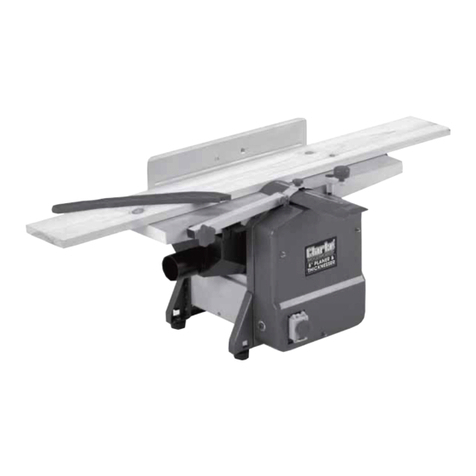
Clarke
Clarke Woodworker CPT600 Installation and operation manual
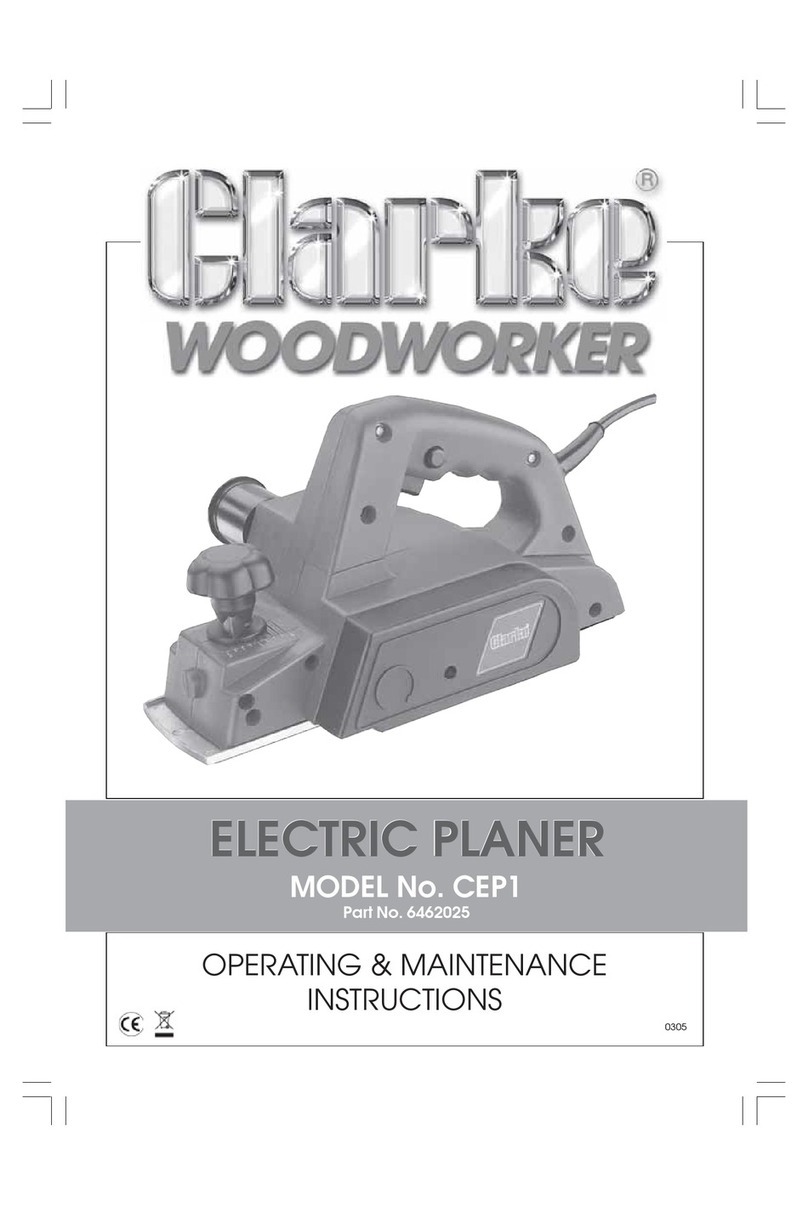
Clarke
Clarke CEP1 Installation and operation manual
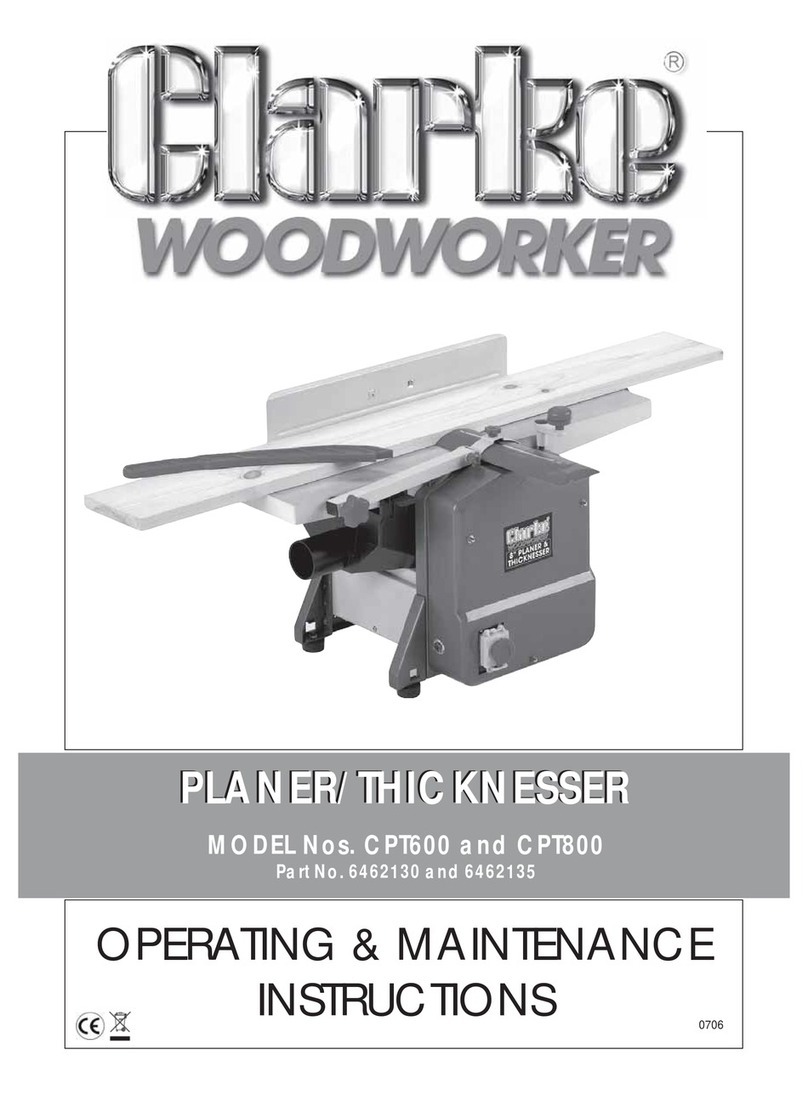
Clarke
Clarke Woodworker CPT600 Installation and operation manual
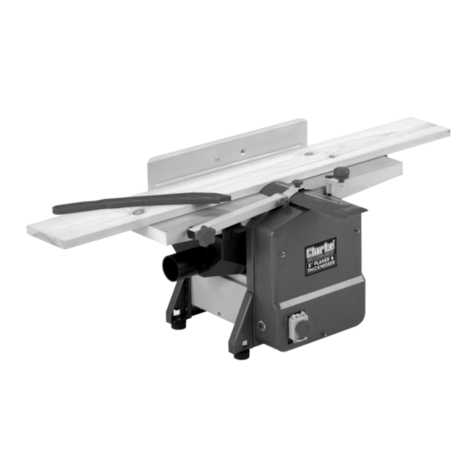
Clarke
Clarke Woodworker CPT600 Instruction Manual
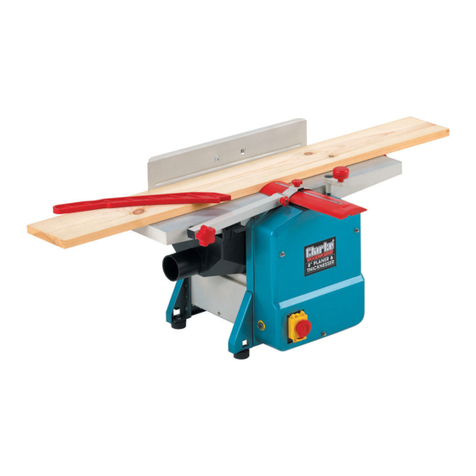
Clarke
Clarke Woodworker CPT800 Instruction Manual
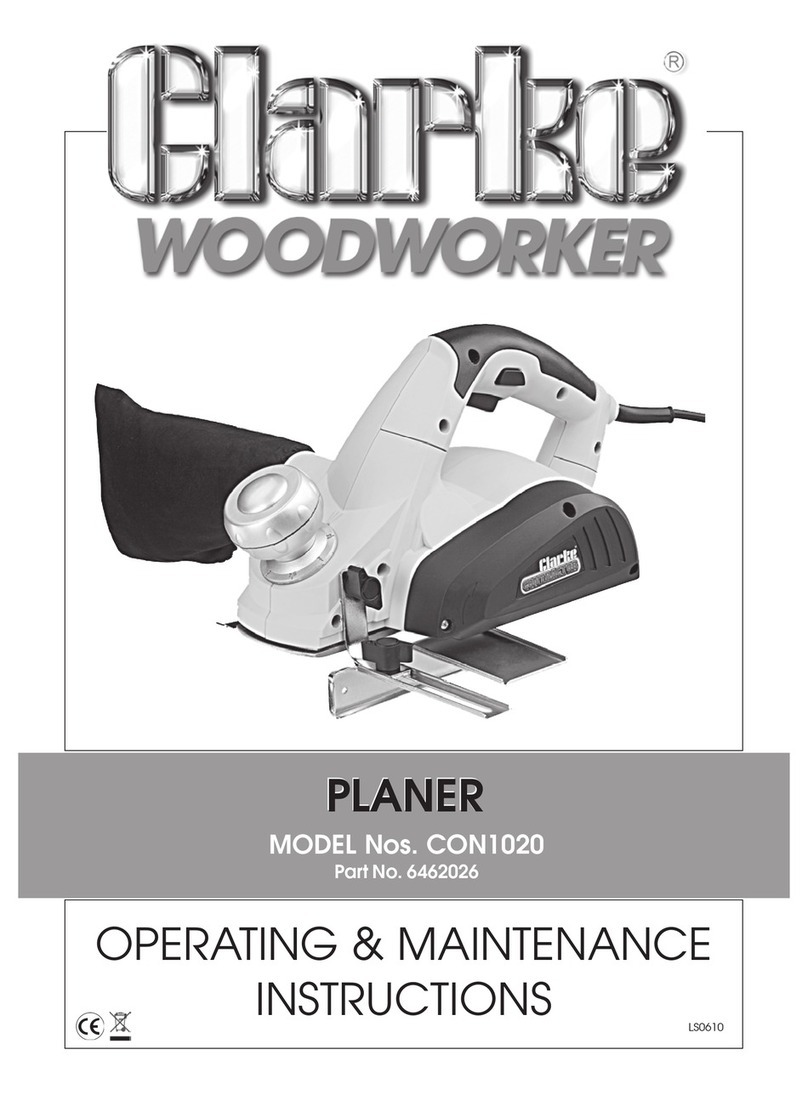
Clarke
Clarke WOODWORKER CON1020 Installation and operation manual
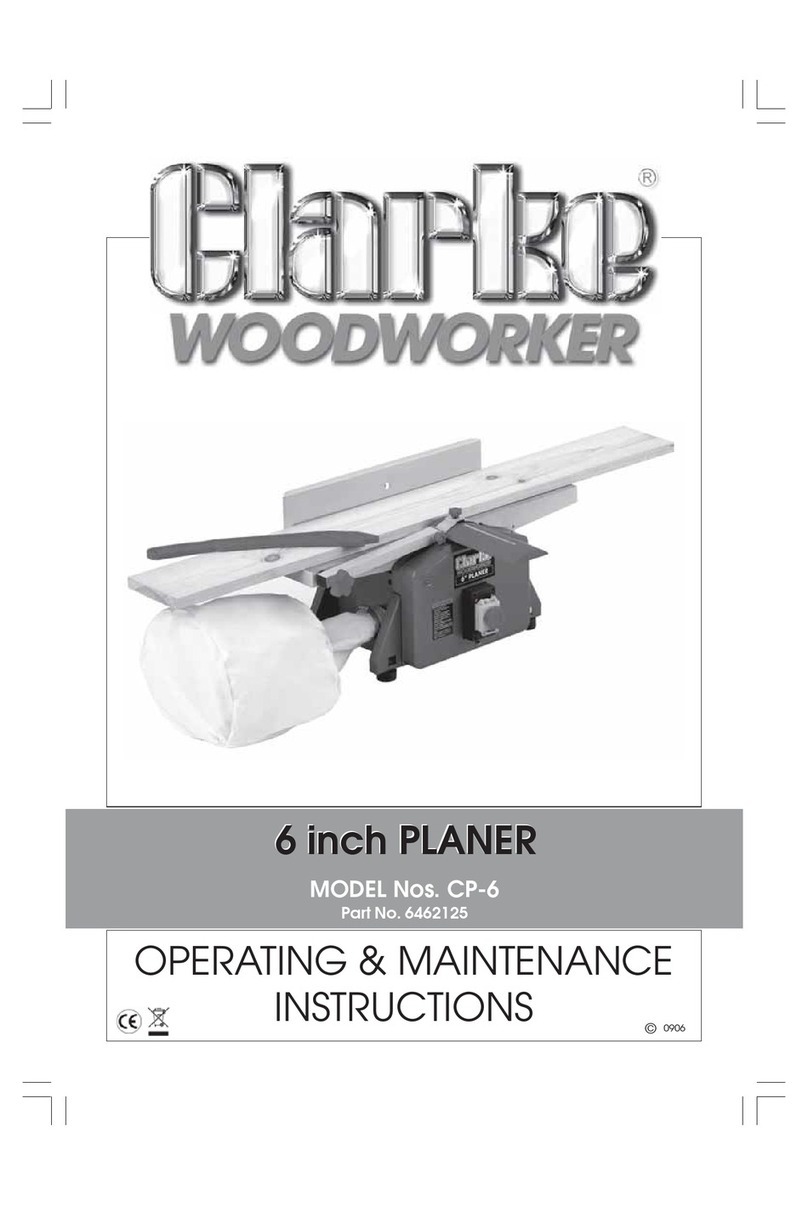
Clarke
Clarke CP-6 Installation and operation manual
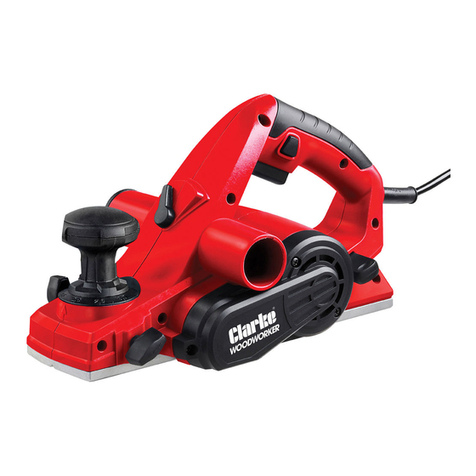
Clarke
Clarke CEP720B Instruction Manual
